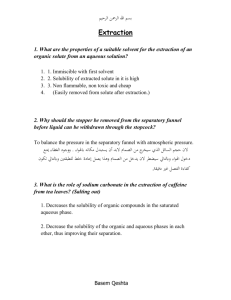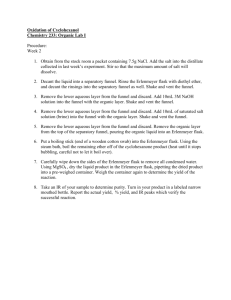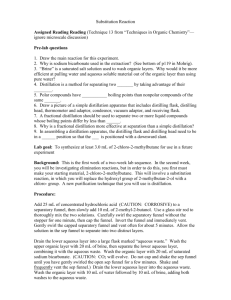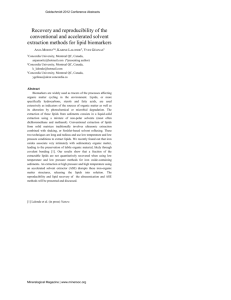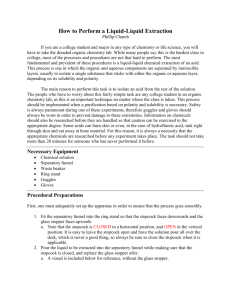1b. ext post
advertisement
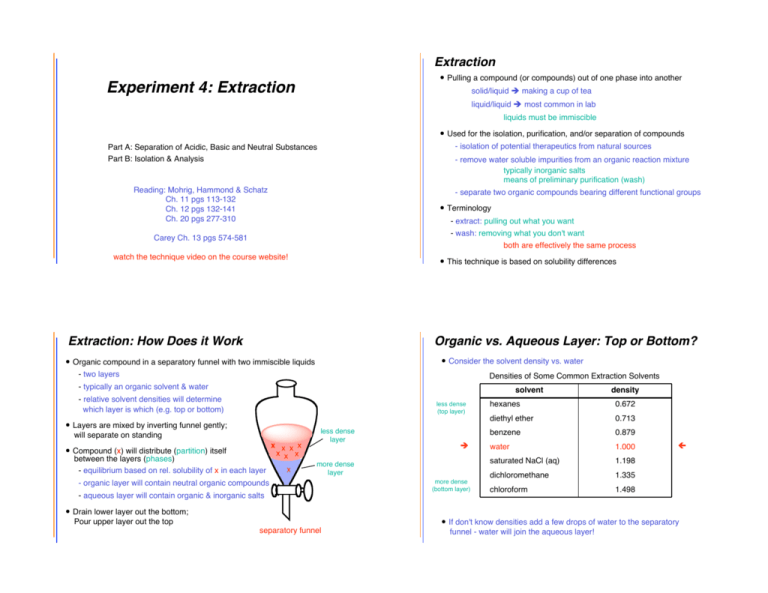
Extraction • Pulling a compound (or compounds) out of one phase into another Experiment 4: Extraction solid/liquid ! making a cup of tea liquid/liquid ! most common in lab liquids must be immiscible • Used for the isolation, purification, and/or separation of compounds - isolation of potential therapeutics from natural sources Part A: Separation of Acidic, Basic and Neutral Substances Part B: Isolation & Analysis - remove water soluble impurities from an organic reaction mixture typically inorganic salts means of preliminary purification (wash) Reading: Mohrig, Hammond & Schatz Ch. 11 pgs 113-132 Ch. 12 pgs 132-141 Ch. 20 pgs 277-310 - separate two organic compounds bearing different functional groups • Terminology - extract: pulling out what you want - wash: removing what you don't want Carey Ch. 13 pgs 574-581 both are effectively the same process watch the technique video on the course website! • This technique is based on solubility differences Extraction: How Does it Work Organic vs. Aqueous Layer: Top or Bottom? • Consider the solvent density vs. water • Organic compound in a separatory funnel with two immiscible liquids - two layers Densities of Some Common Extraction Solvents - typically an organic solvent & water solvent - relative solvent densities will determine which layer is which (e.g. top or bottom) less dense (top layer) • Layers are mixed by inverting funnel gently; will separate on standing • Compound (x) will distribute (partition) itself between the layers (phases) - equilibrium based on rel. solubility of x in each layer x x x x x x x x less dense layer ! more dense layer - organic layer will contain neutral organic compounds - aqueous layer will contain organic & inorganic salts • Drain lower layer out the bottom; Pour upper layer out the top separatory funnel more dense (bottom layer) density hexanes 0.672 diethyl ether 0.713 benzene 0.879 water 1.000 saturated NaCl (aq) 1.198 dichloromethane 1.335 chloroform 1.498 " • If don't know densities add a few drops of water to the separatory funnel - water will join the aqueous layer! Distribution Coefficient (K) Extraction • Extraction Efficiency: - For an efficient extraction (water ! organic solvent), K ! 4 • Ratio of concentrations of a compound [X] in the layers is known the distribution coefficient (K) - If K < 1, will be difficult to extract the compound from water K= [X] in organic solvent [X] in water ! solubility of X in organic solvent • What if extraction efficiency is poor?? - increase number of extraction steps solubility of X in water more efficient to carry out multiple small extractions than 1 large one even if K ! 4 • If know solubility's, can calculate K so 3 x 5mL extraction better than 1 x 15mL extraction!! - saturate the aqueous layer with NaCl ("salting out") If for compound X: solubility in water is 5g/100 mL "solubility in an organic solvent is 35 g/100 mL K= 35g/100mLB 5g/100mLA = 0.35 shift the equilibrium (change K) = 7 0.05 • How can we use extraction to separate two (or more) organic compounds? - modify solubility? K gives us information about extraction efficiency General Principles Separation of a Mixture by Extraction # start with a mixture of compounds dissolved in an organic solvent # Extract With Removes Why? water H2O polar, low MW compounds inorganic acids & bases polar organics with <5 carbons solubility acid HCl basic compounds inorganic bases R-NH2 weak base NaHCO3 strongly acidic compounds inorganic acids R-CO2H (pKa ! 5) strong base NaOH Na2CO3 acidic compounds OH (pKa ! 10) R NH2 O R HCl H R NH2 O NaHCO3 R OH OH NaOH Cl O Na O Na Drying Agents Next Week • Used to remove final traces of water from organic solutions • Typically anhydrous, inorganic salts ! readily hydrate • Typical drying agents include: Capacity Speed Applications calcium chloride calcium sulfate magnesium sulfate Drying Agent CaCl2 CaSO4 MgSO4 high low high medium fast fast potassium carbonate sodium sulfate K2CO3 Na2SO4 medium high medium slow hydrocarbons generally useful not for very acid sensitive cmpds not for acidic cmpds generally useful • Procedure - add a small amount of solid drying agent to the organic solution - swirl; drying agent should be free flowing (not clumped); avoid excess - let stand (swirl occasionally) for 5-15 minutes - filter or decant solution away from drying agent Extraction Overview 1. Your mixture contains the following components (dissolve in ether) (October 3 - 7) Experiment 4: Extraction A. Separation of a 3-Component Mixture by Extraction strong organic acid - benzoic acid (carboxylic acid) organic base - 4-chloroanaline (amine) neutral substance - 1,4-dimethoxybenzene (ether) B. Isolation & Analysis recover compounds by neutralization/filtration or evaporation evaluate success of separation by TLC & melting point confirm identity of separated components by IR Exp 4 Notebook: Research Plan MUST be a flowchart use the entire page for the flowchart; experimental section will follow on a new page DUE: Distillation Lab Report (exp 3) Lab Reports are due at the beginning of your regular lab session Extraction Technique: The Basic Setup • separatory funnel set in a ring (be sure it is the right size) • stopper & stopcock should fit avoid leaks funnel (optional) • stopcock should be closed! 2. Separation of the 4-chloroaniline (an amine) is achieved by extracting the mixture with acid Ar-NH2 + HCl ! Ar-NH3+ Cl 3. The benzoic acid (a carboxylic acid) is separated upon extraction with base Ar-CO2H + NaOH ! Ar-CO2- Na+ 4. The 1,4-dimethoxybenzene will remain in the organic layer • collection flask below "just in case" metal ring • add solution slowly avoid spills - use a funnel • solution must be cool avoid large pressure build up ring stand stopper stopcock should be closed!!! note that the tip of the funnel is below the rim of the flask! empty flask or beaker Extraction Technique: Separation Experimental Details • add appropriate aqueous reagent to the solution • Separation • stopper the funnel and invert hold on to the stopper! 1. Obtain approximately 1.5g compound mixture (1:1:1 ratio by weight) - record accurate weight (does not need to be 1.50g!) • vent carefully release pressure; vent gases point funnel away from yourself & others CAUTION! escaping gases 3. Add HCl to the separatory funnel; stopper and invert separatory funnel to mix - be sure you know which layer is which! - vent frequently to prevent pressure build-up • repeat several times DON'T SHAKE! avoid emulsions • set funnel back into ring 4. Separate layers - wait for separation to occur, then drain lower layer ! aqueous layer - will contain amine salt (flask #1) - organic layer remains - will contain benzoic acid & 1,4-dimethoxybenzene • allow layers to separate be sure you know which layer is which! • remove stopper so funnel will drain! • drain lower layer through stopcock keep tip of funnel below rim of container • pour upper layer out through top avoid contamination 2. Dissolve in ether ! transfer resulting solution to the separatory funnel - use a little extra solvent to complete transfer hold stopper securely! Experimental Details 6. Add NaOH to separatory funnel; stopper and invert sep funnel to mix - mix thoroughly -- deprotonation of benzoic acid is a bit slow 5. Repeat steps 3-4 - to ensure complete extraction of the amine from the organic layer - REMEMBER: multiple extractions using smaller amounts of reagent are more efficient than a single extraction with the same reagent volume! Experimental Details • Isolation of Components Flask 3: organics; dry over anhydrous Na2SO4 swirl to mix; should be some free-flowing solid - more is not better - let sit for 5-10 min (keep busy while you wait!) decant liquid into tared roundbottom flask concentrate using the rotary evaporator - no sand baths! Fire Hazard! - HINT: place flask with organics in back of hood and do something else while you wait for the rotavap! Flask 1: acidic extracts; make basic with concentrated NaOH (check pH) 7. Separate layers as before - wait for separation to occur, then drain lower layer ! aqueous layer - will contain carboxylic acid salt (flask #2) - organic layer remains - will contain 1,4-dimethoxybenzene 8. Repeat steps 6 & 7 - to ensure complete extraction of the carboxylic acid from the organic layer 9. Wash organic layer with saturated NaCl (aq) - preliminary drying - drain lower layer out through bottom (set aside to discard later) - pour top layer out through top of sep funnel (flask #3) ! will contain 1,4-dimethoxybenzene Ar-NH3+ Cl - + NaOH ! Ar-NH2 ($) cool & collect crystals Flask 2: basic extracts; make acidic with concentrated HCl (check pH) Ar-CO2- Na+ + HCl ! Ar-CO2H ($) cool & collect crystals Experimental Details Some Pointers: • Finishing Up • Label your flasks! - one Erlenmeyer/beaker looks pretty much like the next 1. dry samples - samples #1 & 2 will be very wet; first press between two pieces of filter paper, then dry under vacuum (be sure side arm test tube is clean!!) • NEVER throw anything away until you're absolutely sure you don't need it - you can always dispose of it later - once discarded, it's tough to get it back! 2. weigh samples (& calculate % recovery) - how much of each compound can you expect to recover? • When extracting, invert funnel gently - don't shake - keeps emulsions from forming - emulsions will take a long time before layers separate 3. determine melting point of each compound • Vent frequently - avoid pressure build up - sep funnel could explode 4. evaluate success of separation by TLC - spot initial 1:1:1 mixture, plus 3 isolated components - developing solvent is chloroform (use in the hood!) - how can you tell if separation was successful? • During isolation, be sure solutions are acidic/basic (check with pH paper) - do NOT dip paper into solution; use a boiling stick or glass rod - MIX THOROUGHLY after each addition of HCl or NaOH 5. Get IR spectra from your TA - use to confirm identity of each component • Come prepared - easy to get confused if you're not clear on what you're doing - must write a flow sheet for the pre-lab research plan (use the entire width of the page) Infrared Spectroscopy (IR) Infrared Spectroscopy • Infrared region of electromagnetic spectrum ": 2,500-16,000 nm #: 1.9 x 1013 - 1.2 x 1014 Hz • Absorption in specific region in IR spectrum corresponds to specific types of molecular vibrations: FREQUENCY (cm-1) 4000 • Photon energies associated with this region are weak - not large enough to excite electrons - can induce vibrational excitation of covalently bonded atoms & groups 3600 3200 H C H C H H H symmetric stretch asymmetric stretch scissoring (in plane bending) 2000 1800 1600 tr ip l e bon ds 1400 1200 do ubl e bon ds O-H, N- H 1000 800 600 fi nge rp ri nt re gi on C= O C !C, C !N C-C, C-O, C- N, etc . C !O, et c . • Wide variety of vibrational motions; commonly talk about "stretching & bending" e.g. for C-H bond H 2400 Bon ds t o H • Exact frequencies of vibrations determined by the strength of the bonds involved and the masses of the connected atoms C 2800 C=C C= N C-H 2.5 3.0 3.5 4.0 5 6 (MICRON S ) Ar-H 7 8 9 10 11 12 13 14 16 Infrared Spectroscopy Identification of Mixture Components • Plot light absorbsed/transmitted as a function of frequency, can determine what types of functional groups are present in a molecule Distinguishing features by IR spectroscopy (see Carey, pg 579) • Carboxylic acids - broad OH stretch (ca. 3000 cm-1) - may be diffuse - C=O stretch (ca. 1710 cm-1) • Amines - NH stretch (ca. 3400 cm-1) - 2 bands for a NH2 group C-H stretch IR spectrum of tert-butylbenzene • Ethers - none of the above - will likely see minor FG absorbances C-H stretch (ca. 2850-3150 cm-1) C-O stretch (ca. 1000-1250 cm-1) - minor absorbances will be present in acid & amine spectra as well SDBS Database National Institute of Advanced Industrial Science and Technology; 11/7/07 Infrared Spectrum of a Carboxylic Acid O R Infrared Spectrum of an Amine (RNH2) R-NH2 OH NH stretch OH stretch C=O stretch % NO C=O Infrared Spectrum of an Ether OR Writing the Lab Report: Exp #3 Distillation ! Purpose - technique experiment: what will you learn? - what conclusions will you reach? - a general discussion of theory/expected results is not a purpose! will show minor FG absorbances only ! Results & Discussion - Plot data for both simple & fractional distillations (include graphs) these are essentially temp vs time plots as discussed in class raw data (# drops vs temperature) does not belong here! - Evaluate data ! simple distillation discuss temp vs. volume graph (equiv to temp vs. time!) compare to theory (what do you expect to see)? C-H stretch C-O stretch % % NO NH NO C=O e.g. what does the temperature change indicate? are the drops pure? does purity vary? report % recovery and % holdup Writing the Lab Report: Exp #3 Distillation ! Results & Discussion - Evaluate data ! fractional distillation discuss same topics as for simple distillation - Compare the two distillation techniques compare how well the two components separated in each case what data can you use? do your results agree with your expectations? explain! what does plot tell you about composition of drops over time? bp recorded vs known bp Temp vs. Vol plots discuss differences in % holdup and % recovery relates to the efficiency of the two processes - Decide which method is better for the separation of cyclohexane & toluene clearly explain why you made this choice (based on your results) do your findings agree with your expectations? again, first must decide what you expect to see your expectations shouldn't influence interpretation of your data Writing the Lab Report: Exp #3 Distillation ! Conclusion - a brief recap of your findings - make a general statement about distillation techniques you studied - should be brief (2-3 sentences) ! Appendix A: Calculations - Percent Recovery % recovery = amount distillate recovered (mL) amount of original solution (mL) x 100 - Percent Holdup amount of material retained by the distillation apparatus % holdup = amount liquid left in flask(mL) amount of original solution (mL) x 100


